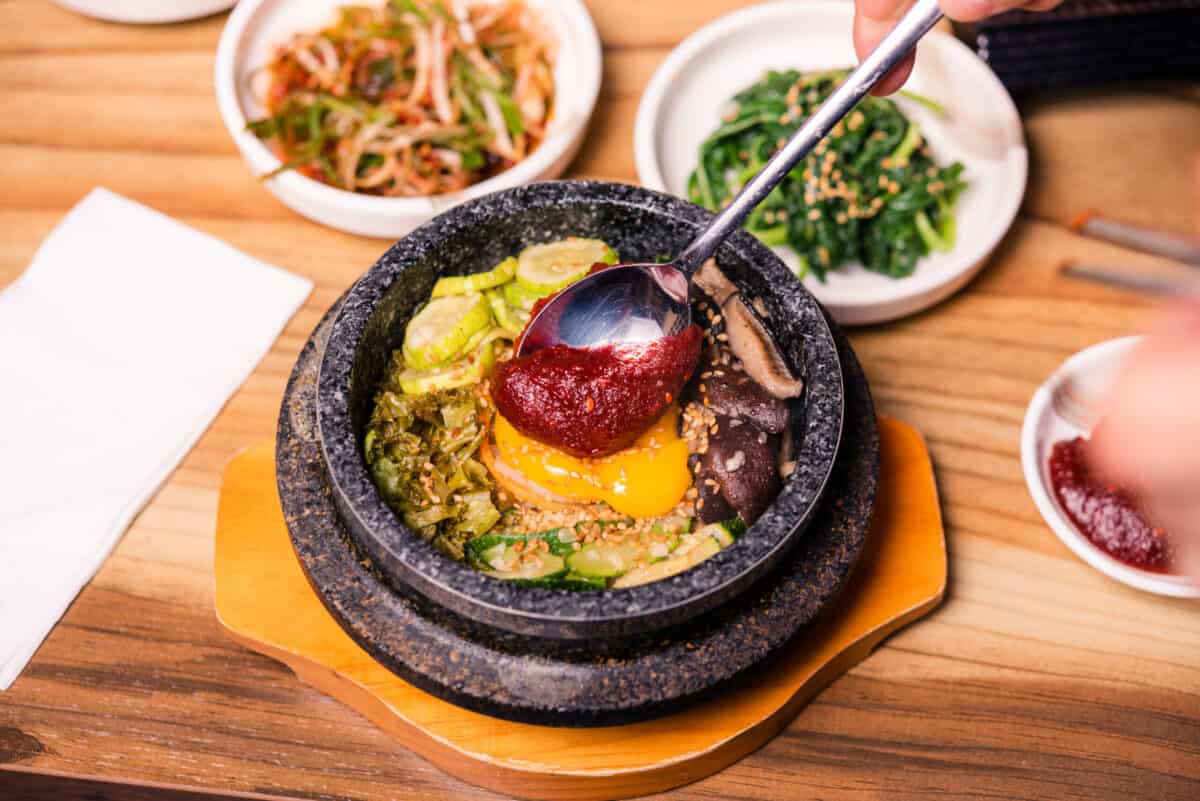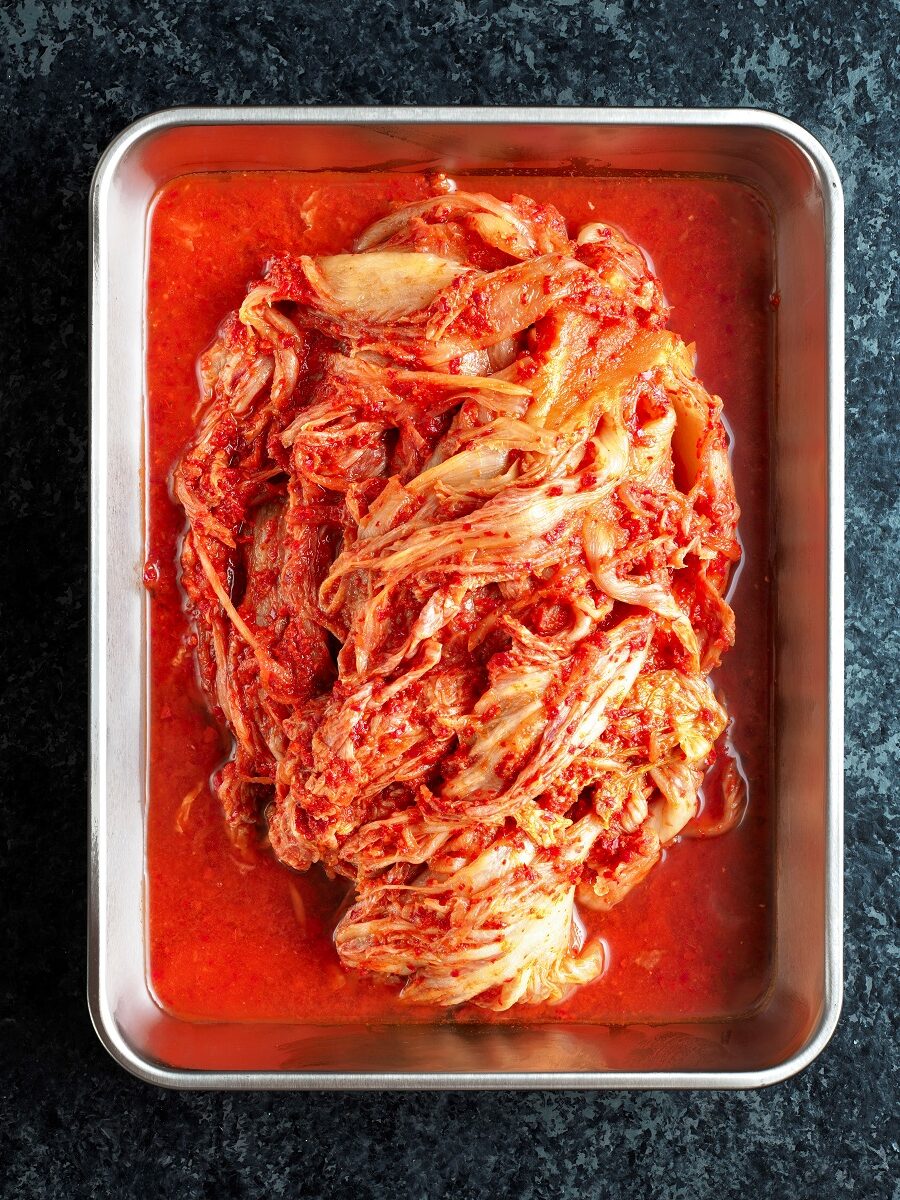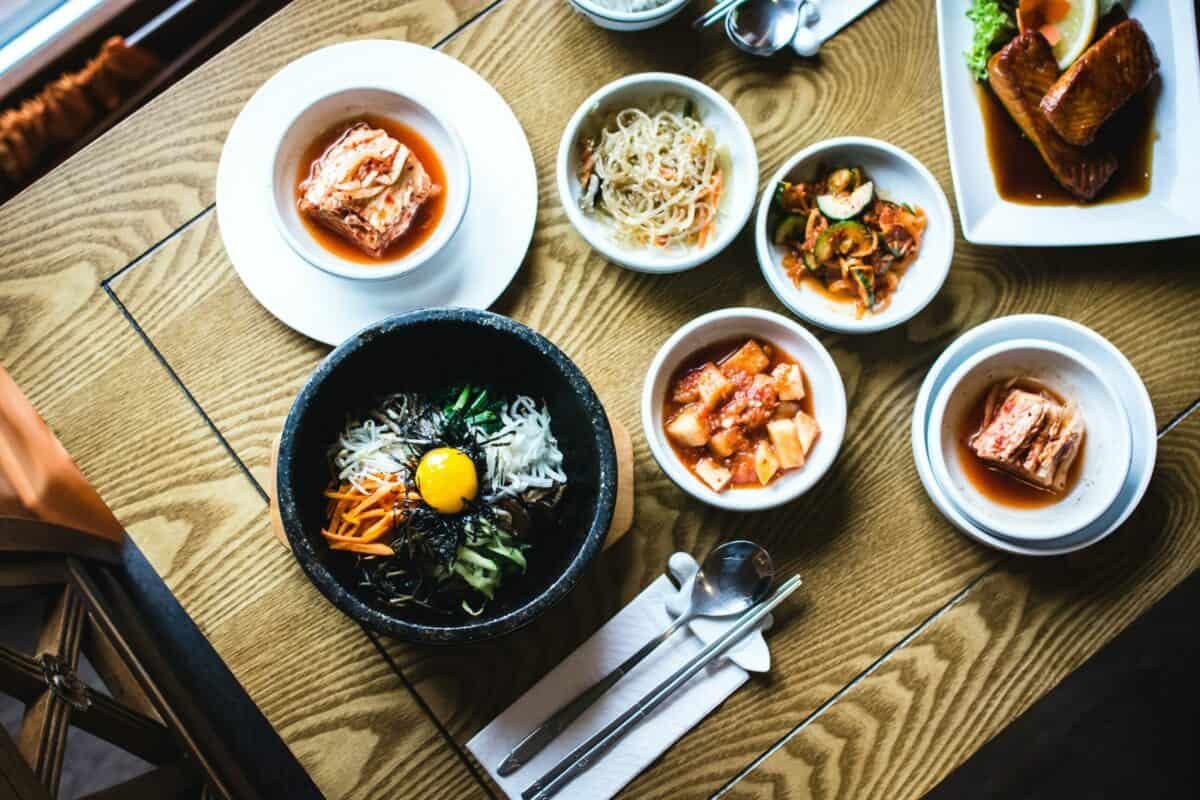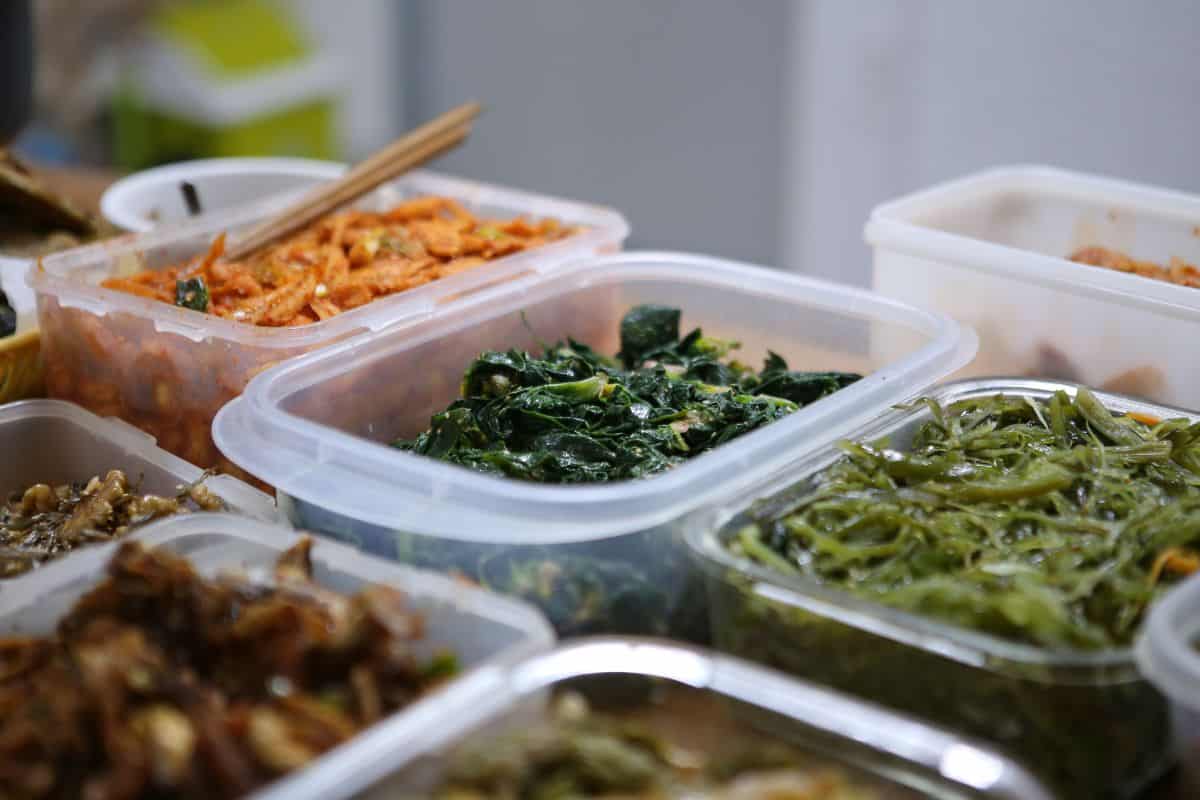The Korean diet is celebrated for its assorted array of flavors and nutritional benefits. It typically features a balance of rice, vegetables, and fermented foods like kimchi, along with meats and seafood.
The methods employed in Korean cooking, such as grilling, fermenting, and boiling, contribute to its healthy reputation.
The Korean diet also includes high-fiber vegetables and grains, along with moderate protein. This aligns with what many dietitians regard as a balanced approach to eating. Traditional Korean meals are also notable for their portion sizes, which are modest and conducive to preventing overeating.
Adding to the diet's health advantages are fermented foods such as kimchi, which are rich in probiotics, aiding in digestion and strengthening gut health. This fermentation process also extends the shelf life of food, ensuring that the diet is both sustainable and nutritious.
🥘 Foundations of the Korean Diet
Historic Origins
The traditional Korean diet has evolved over centuries, shaped by the natural environment and cultural practices of Korea. Historically, this diet consisted largely of plant-based foods, with meat and fish being consumed in moderation. Agriculture, particularly rice farming, played a significant role in shaping the Korean diet, with rice as a staple food.
Core Components
Grains and Vegetables:
- Rice: A staple of nearly every meal.
- Kimchi: Fermented vegetables, packed with probiotics.
Proteins:
- Seafood: Consumed regularly, providing essential omega-3 fatty acids.
- Tofu and Legumes: Alternative protein sources that are prominent in Korean cuisine.
Flavorings and Condiments:
- Gochujang: A spicy and sweet red pepper paste.
- Ganjang: A type of soy sauce used for seasoning and marinating.
The diet's emphasis on vegetables like kimchi, which is high in vitamins, and the use of minimal fat in cooking methods, showcases Korea's commitment to nutrition and health. Lean proteins from both land and sea contribute to a balanced diet, while the various flavorings add depth without unnecessary calories, making the Korean diet notably healthy.

🔎 Key Characteristics of Korean Cuisine
Abundance of Vegetables
Korean dishes are often rich in vegetables including spinach, bean sprouts, and various types of mushrooms. These ingredients are not only prominent in main dishes but also in side dishes known as banchan. These small side dishes often feature seasoned vegetables and provide a spectrum of nutrients and fibers.
Preference for Seafood and Lean Meats
While rice serves as the backbone of Korean meals, the diet also shows a preference for proteins like seafood and lean meats. Fish along with chicken, pork, and beef, are typically prepared with flavorful marinades that include garlic, onions, and soy sauce, catering to the palate while maintaining nutritional value.
Rice as a Staple Food
Rice in Korean cuisine isn’t just a filler; it's a cherished part of every meal. Both white rice and healthier options like brown rice provide energy and serve as a vehicle for flavors from accompanying dishes. They complement the variety of textures and tastes found in Korean meals.
Fermented Foods and Probiotics
A distinctive feature of Korean food is its variety of fermented foods, such as the internationally adored kimchi, which is made from various seasoned vegetables. These fermented items are a source of probiotics, which support digestive health. The process of fermentation also increases the bioavailability of nutrients, making Korean cuisine beneficial for gut health.

🩺 Health Benefits and Nutrition
Low Calorie, High Nutrient Density
Korean meals are characteristically low in calories yet rich in vitamins and minerals. They typically include a variety of fermented and fresh vegetables like kimchi, which is not only low-calorie but also loaded with vitamins A and B as well as fiber, contributing to a high nutrient density. For more insights, consider the benefits of kimchi.
Healthful Cooking Methods
The traditional cooking methods such as grilling, boiling, and fermenting are prevalent in Korean cuisine. These methods significantly reduce the need for fats while cooking, hence decreasing the overall fat content in food. This utilization of healthier cooking techniques helps retain the nutrients in foods, like the properties found in spices such as ginger.
Balanced Macronutrients
The Korean diet provides a balanced proportion of macronutrients—carbohydrates, proteins, and healthy fats. A typical meal might comprise of staples like rice (carbs), tofu or fish (protein), and healthy fats from seeds or nuts. The harmonious balance supports bodily functions and sustains energy levels throughout the day.
Medicinal Properties of Korean Spices
Korean spices, such as ginger and gochugaru, have long been considered to possess medicinal properties. They not only add flavor but also contribute health benefits like anti-inflammatory effects and aiding in digestion. Spices are integral in many Korean recipes, helping to improve meals' nutritional profiles while enriching taste.
😋 Common Korean Dishes and Their Benefits
The Significance of Kimchi
Kimchi, a staple in Korean cuisine, is a fermented dish usually made from cabbage and a variety of spices. Rich in vitamins A and C, kimchi is also packed with probiotics due to the fermentation process, which promotes gut health. Dishes like Kimchi Fried Rice not only add flavor to a meal but also provide these digestive benefits.
The Role of Soups and Stews
Korean soups and stews, such as Soondubu (soft tofu stew), are integral to the Korean diet. They often contain a multitude of ingredients like vegetables, tofu, and sometimes meats or seafood, leading to a hearty meal low in calories but high in nutrition. These soups often offer a balance of macronutrients and are hydrating due to their broth content, making them a comforting yet healthy choice.
Popular Korean Meals
Bibimbap and Korean Fried Chicken represent the spectrum of Korean dishes, from health-conscious to indulgent options. Bibimbap, a mixed rice dish with vegetables, egg, and optional meat, is a nutrient-dense meal covering various food groups. Contrastingly, Korean Fried Chicken, while not as nutrient-focused, provides a rich flavor experience and is often enjoyed in moderation within a balanced diet. Meals like ssam, which involves wrapping meat in leafy greens, offer another way to enjoy a nutritious and interactive dining experience.

🧑⚕️ Korean Dietary Practices
Typical Meal Structure
A traditional Korean meal is centered around rice and soup, with a variety of side dishes, known as banchan, creating a multi-flavored dining experience. This structure supports a well-rounded intake of carbohydrates, proteins, and vitamins. Meals are enjoyed as a shared experience, promoting communal eating which is considered to add to the meal's enjoyment and healthfulness.
Side Dishes and Banchan Culture
Banchan refers to the array of side dishes that accompany a Korean meal. They are served in small portions but with large variety, typically including fermented vegetables like kimchi, stir-fried vegetables, and protein-rich items. The side dishes are not only delicious but also allow for a diverse nutrient intake with every meal, making the Korean diet highly nutritious.
Snacking and Street Foods
Street foods and snacks play an integral part in Korean food culture. Snacks like rice cakes (tteokbokki) and savory pancakes (jeon) are ubiquitous, offering a quick, tasty, and often spicy treat between meals. Street foods in Korea are not just about satisfying hunger pangs but also about enjoying flavorsome and hearty options that are an extension of the Korean way of eating.

❓ Frequently Asked Questions
Korean foods that are beneficial for weight loss typically include dishes with high vegetable content, lean proteins, and fermented foods. Examples are kimchi, which is known for its probiotic qualities, and bulgogi, a marinated beef dish that's usually grilled, providing protein without excess calories. The Korean diet's emphasis on balance and variety can be directly linked to managing weight effectively.
The Korean diet is rich in foods containing antioxidants and anti-inflammatory properties, such as green tea and gochujang. These components can help protect the skin against damage from free radicals and can promote a healthy complexion. Furthermore, the diet's high intake of fermented foods may support gut health, which is closely tied to maintaining clear skin.
Healthy Korean food recipes often involve fresh ingredients and minimal use of oil. Bibimbap, a mixed rice dish with assorted vegetables, and Japchae, a stir-fried noodle dish made with sweet potato noodles and mixed vegetables, are both nourishing options. These dishes offer a balance of carbohydrates, proteins, and essential nutrients while being low in unhealthy fats.
Koreans have long consumed a diet that includes whole grains, fish, and lean meats. They also eat a plethora of vegetables. Fermented foods like kimchi are staples known for their potential health benefits. These food items are loaded with nutrients that may promote longevity. They support cardiovascular health and maintain a healthy body weight.





Comments
No Comments